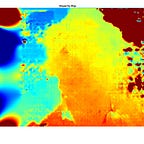Chaos & Logistic Map
The logistic map is one of the simplest non-linear recursive equations that have chaotic behaviour. This dynamical equation is polynomial of degree 2, and it was first popularized by Robert May. The logistic map can be written as:
where x_n is a normalized value in the range [0–1], and it usually represents the ratio of the existing population to the maximum possible population. The parameter 0 ≤ r ≤ 4, represents the intrinsic growth rate or fertility rate.
The logistic map has pathological problems, for the value of r > 4 will lead to some negative results.
The Intrinsic Growth Rate Parameter:
This equation has different behaviour for different values of r:
When 0 ≤ r <1, the population will die out despite the initial conditions.
When 1 ≤ r < 2, the population will quickly approach (r-1)/r despite the initial conditions.
When 2 ≤ r < 3, will eventually reach (1-r)/r and it will fluctuate around this value.
When 3 ≤ r < 3.5699, things start getting weird, 3 ≤ r < 3.44949 the population will reach permanent oscillation between two values for almost all initial conditions. And when 3.44949 ≤ r < 3.54409, the population will exhibit what is known as period-doubling and it will reach permanent oscillations amount four values. And the same when 3.54409 ≤ r the population will bifurcate to 8, 16, 32, … values. The length between two successive bifurcations interval approaches 4.669 what is known as the Feigenbaum constant.
When r ≤3.5699, then the population will exhibit chaotic behaviour, the bifurcations will no longer be visible, but there are still some regions of r that are showing bifurcations again.
And when r ≤ 4, almost all the initial values will leave the interval [0, 1] with some negative values.
In fact, this behaviour does not exist in this equation only, every unimodal map, scale like this for example:
All of the above equations shows similar behaviour at different scales.
